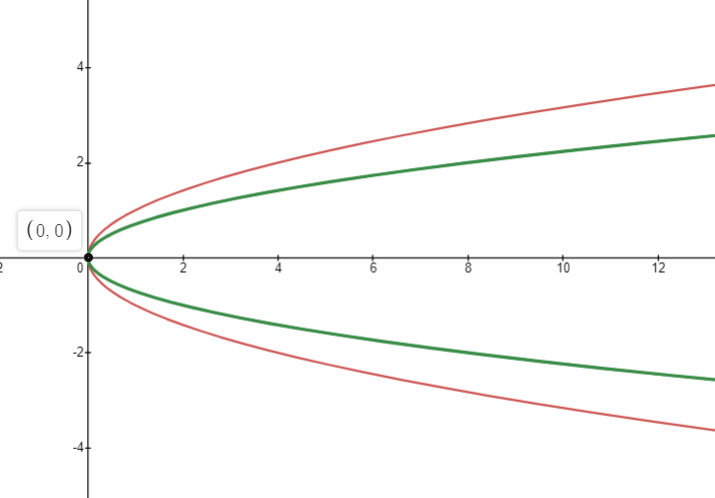
If O is the origin and Q is a variable point of ${{y}^{2}}=x$. Find the locus of the mid-point of OQ.
Answer
505.5k+ views
Hint: We first find the parametric form of the equation of parabola ${{y}^{2}}=x$. We find the value of the parameter $a$. We take the point Q and find the midpoint of OQ. The locus will be defined for the midpoint using the formula of $\left( \dfrac{c+m}{2},\dfrac{d+n}{2} \right)$.
Complete step by step solution:
O is the origin and it will be considered as the coordinates of $\left( 0,0 \right)$.
Q is a variable point of ${{y}^{2}}=x$. Any arbitrary point of a parabola will be considered as the coordinates of $\left( a{{t}^{2}},2at \right)$. It is the parametric form of the parabola. We need to find the value of $a$.
So, \[{{\left( 2at \right)}^{2}}=a{{t}^{2}}\Rightarrow 4{{a}^{2}}=a\]. Now the value of $a$ cannot be 0.
\[\begin{align}
& 4{{a}^{2}}=a \\
& \Rightarrow 4a=1 \\
& \Rightarrow a=\dfrac{1}{4} \\
\end{align}\]
The parametric coordinates of a point on ${{y}^{2}}=x$ will be $Q=\left( \dfrac{{{t}^{2}}}{4},\dfrac{t}{2} \right)$.
Now we need to find the locus of the mid-point of OQ.
The general formula of mid-point of two points $A\left( c,d \right)$ and $B\left( m,n \right)$ will be $\left( \dfrac{c+m}{2},\dfrac{d+n}{2} \right)$.
Following the formula, we get the midpoint of OQ as $\left( h,k \right)\equiv \left( \dfrac{\dfrac{{{t}^{2}}}{4}+0}{2},\dfrac{\dfrac{t}{2}+0}{2} \right)=\left( \dfrac{{{t}^{2}}}{8},\dfrac{t}{4} \right)$.
We get the value of $t$ as $k=\dfrac{t}{4}$ which gives $t=4k$.
We put the value in the equation of $h=\dfrac{{{t}^{2}}}{8}$ and get $h=\dfrac{{{\left( 4k \right)}^{2}}}{8}=2{{k}^{2}}$.
We now change the equation $h=2{{k}^{2}}$ to normal form and get $x=2{{y}^{2}}$.
Therefore, the locus of the mid-point of OQ is $x=2{{y}^{2}}$.
We can see the graph of the parabola $x=y^2$ (red) and the locus of the midpoint of OQ $x=2y^2$ (green)f below.

Note:
We need to be careful about the vertex of the parabola. As it is the origin $\left( 0,0 \right)$, we can take the parametric coordinates as $\left( a{{t}^{2}},2at \right)$.
Complete step by step solution:
O is the origin and it will be considered as the coordinates of $\left( 0,0 \right)$.
Q is a variable point of ${{y}^{2}}=x$. Any arbitrary point of a parabola will be considered as the coordinates of $\left( a{{t}^{2}},2at \right)$. It is the parametric form of the parabola. We need to find the value of $a$.
So, \[{{\left( 2at \right)}^{2}}=a{{t}^{2}}\Rightarrow 4{{a}^{2}}=a\]. Now the value of $a$ cannot be 0.
\[\begin{align}
& 4{{a}^{2}}=a \\
& \Rightarrow 4a=1 \\
& \Rightarrow a=\dfrac{1}{4} \\
\end{align}\]
The parametric coordinates of a point on ${{y}^{2}}=x$ will be $Q=\left( \dfrac{{{t}^{2}}}{4},\dfrac{t}{2} \right)$.
Now we need to find the locus of the mid-point of OQ.
The general formula of mid-point of two points $A\left( c,d \right)$ and $B\left( m,n \right)$ will be $\left( \dfrac{c+m}{2},\dfrac{d+n}{2} \right)$.
Following the formula, we get the midpoint of OQ as $\left( h,k \right)\equiv \left( \dfrac{\dfrac{{{t}^{2}}}{4}+0}{2},\dfrac{\dfrac{t}{2}+0}{2} \right)=\left( \dfrac{{{t}^{2}}}{8},\dfrac{t}{4} \right)$.
We get the value of $t$ as $k=\dfrac{t}{4}$ which gives $t=4k$.
We put the value in the equation of $h=\dfrac{{{t}^{2}}}{8}$ and get $h=\dfrac{{{\left( 4k \right)}^{2}}}{8}=2{{k}^{2}}$.
We now change the equation $h=2{{k}^{2}}$ to normal form and get $x=2{{y}^{2}}$.
Therefore, the locus of the mid-point of OQ is $x=2{{y}^{2}}$.
We can see the graph of the parabola $x=y^2$ (red) and the locus of the midpoint of OQ $x=2y^2$ (green)f below.

Note:
We need to be careful about the vertex of the parabola. As it is the origin $\left( 0,0 \right)$, we can take the parametric coordinates as $\left( a{{t}^{2}},2at \right)$.
Recently Updated Pages
Master Class 11 Social Science: Engaging Questions & Answers for Success

Master Class 11 Physics: Engaging Questions & Answers for Success

Master Class 11 Maths: Engaging Questions & Answers for Success

Master Class 11 Economics: Engaging Questions & Answers for Success

Master Class 11 Computer Science: Engaging Questions & Answers for Success

Master Class 11 Chemistry: Engaging Questions & Answers for Success

Trending doubts
What is meant by exothermic and endothermic reactions class 11 chemistry CBSE

10 examples of friction in our daily life

One Metric ton is equal to kg A 10000 B 1000 C 100 class 11 physics CBSE

1 Quintal is equal to a 110 kg b 10 kg c 100kg d 1000 class 11 physics CBSE

Difference Between Prokaryotic Cells and Eukaryotic Cells

The camels hump is made of which tissues a Skeletal class 11 biology CBSE




